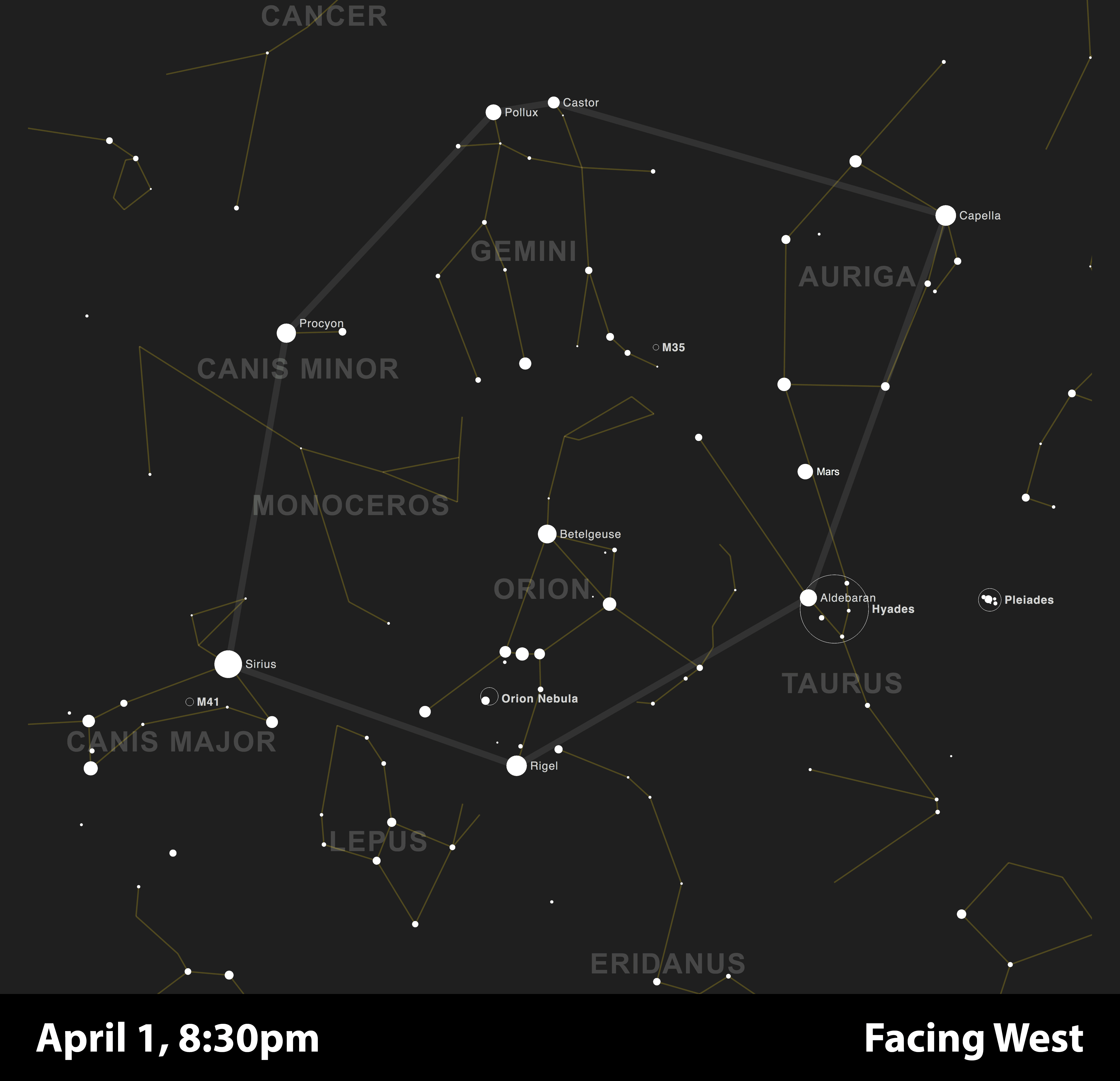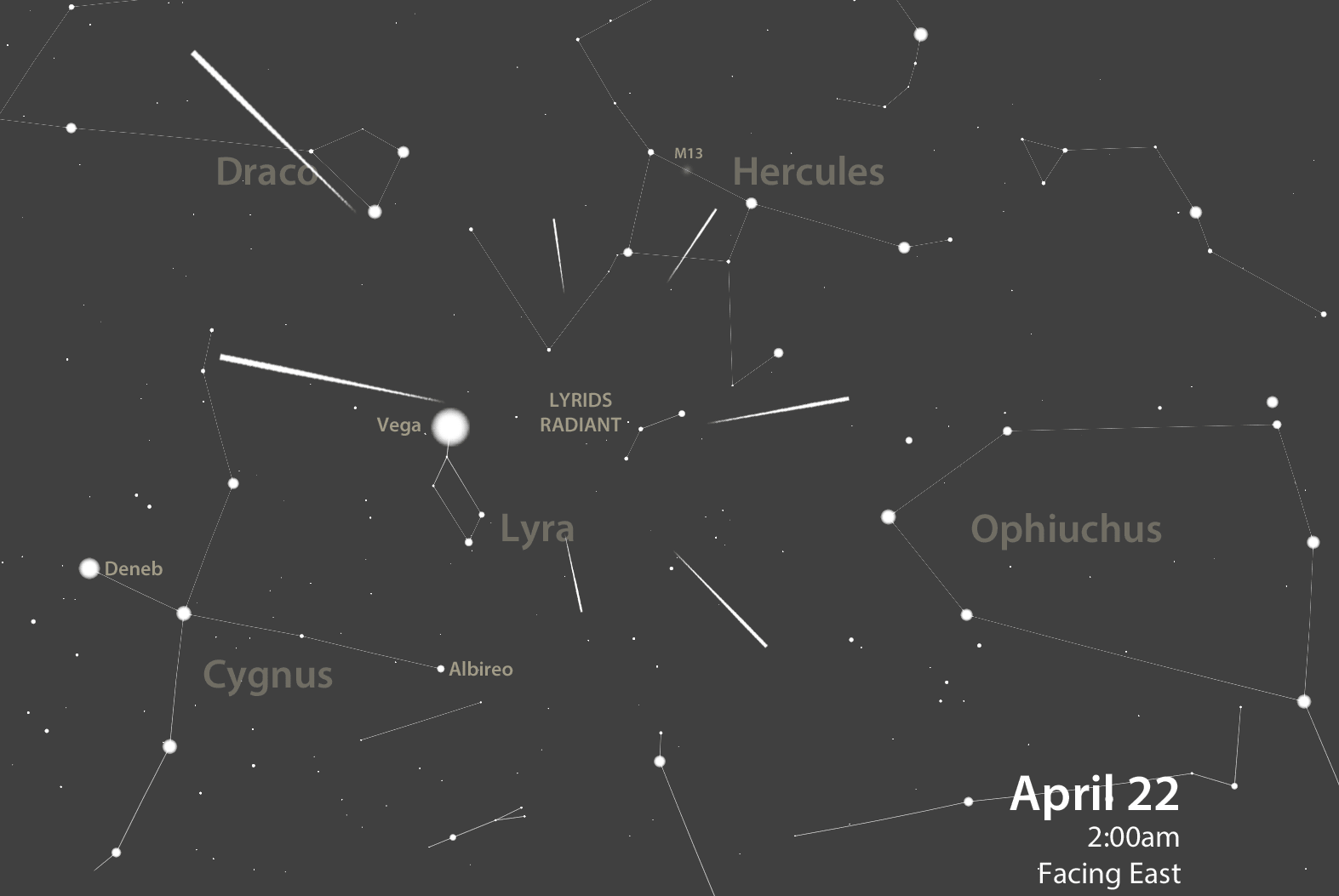Farewell Winter Constellations, Mars Still Visible & April Lyrids Meteor Shower
April 2021 :
Note: This article may contain outdated information
This article was published in the April 2021 issue of The Skyscraper and likely contains some information that was pertinent only for that month. It is being provided here for historical reference only.
Weatherwise spring has hopefully sprung as we begin April. But did you realize that many of the prominent winter constellations can still be observed? If the cold and snowy conditions in February and March prevented you from exploring the winter sky, it’s now time to say farewell to some star patterns that often get overlooked during mid-winter in our region of the country. With public night viewing at Seagrave Observatory and Ladd Observatory closed due to COVID-19, even I did not observe my winter sky friends. It’s difficult to set up a telescope in one’s backyard with 18 inches of snow on the ground.

Once this column is published, I want you to scan the western sky after sunset to bid goodbye to many of the skies’ brightest star patterns. See the accompanying star map. Start with Perseus towards the northwest, then move your gaze south (to the left). Here you will encounter Taurus, with the prominent star clusters named the Pleiades (aka the Seven Sisters) and the Hyades. While a binocular view of the Pleiades does show a nice image, the ideal sight you want to achieve is with a telescope under low magnification so the entire cluster fits into the field of view. In a dark moonless sky the Pleiades remind me of sparkling diamonds scattered upon black velvet.
Above Perseus and Taurus, you’ll find Auriga. To the south (left) of Taurus you’ll encounter the Mighty Hunter Orion. And further to the left will be Canis Major, home of Sirius, the brightest star we can see in our sky other than the Sun. You’ll find Gemini the twins above Orion, and this star pattern will be the last of the winter constellations to set below the horizon.
If you don’t explore anything else in this region of the heavens before the constellations set, then make an effort to observe the Orion Nebula if you haven’t already done so this past winter season. Usually, the local observatories would have focused on this beautiful region of stellar dust and gas for many weeks, but closures prevented that activity during the winter of 2020-2021. In past columns over the years, I have highlighted this remarkable region of space where new stars are in the process of being born. Following is a brief description.
The grandeur of Orion resides in the region of his sword. Using binoculars, you'll see a wispy, hazy patch of green light enshrouding the stars. Using a telescope even under low magnification will reveal a greenish tinged nebula of dust and gas, the magnificent Orion Nebula. I never tire of observing this vast dust cloud, often imagining what this region of space will look like when upwards of 1000 stars will be born here.
Mars Still Visible
Due to the orbital paths of Mars and the Earth, when Mars is visible it remains so for an extended period of time. The contrary is also true. When Mars disappears from view it remains hidden for an extended period of time. Right now, you can still observe Mars, as it resides in the constellation of Taurus. See star map. You may recall that Mars and the Earth had a close encounter back on October 6 of last year when our two worlds were only 38.6 million miles away from one another. At that time Mars was a very bright pumpkin-orange in the night sky and its disk was sufficiently large to see a wealth of detail using a telescope. On April 1 that distance will be 164.5 million miles. Mars will be much dimmer than it was back in October. In fact, it will now be fainter than Taurus’ brightest star Aldebaran. While the planet will appear small even in a modest-sized telescope, perfect seeing conditions may allow one to discern a Martian surface feature or two. It doesn’t hurt to try.
April Lyrids Meteor Shower
I always look forward to a decent display of shooting stars. While the upcoming April Lyrids meteor display on the night of April 21-22 is not a blockbuster event, one can potentially observe upwards of 20 meteors per hour in a dark country sky. The Lyrids appear to radiate outward from an area of sky on the Lyra-Hercules border near the bright star Vega, which will be about 45 degrees (halfway between the horizon and zenith) above the eastern horizon at midnight and well placed for observing.

A bright waxing gibbous Moon, about 70% illuminated, will somewhat reduce visibility of the fainter meteors. However, it will be located more than 100 degrees away to the west in the constellation of Leo, to the right of the backwards question mark asterism. While still a nuisance light source, the Moon shouldn’t compromise your observing session. Try to block the its brightness using a building or some trees.
These swift and bright meteors disintegrate after hitting our atmosphere at a moderate speed of 29.8 miles per second. They often produce luminous trains of dust that can be observed for several seconds. The Moon will set just before 4:00 a.m. EDT, leaving a little more than an hour of moonless sky before dawn’s early light will begin to overwhelm the stars and the meteors.
Best of luck in all your observing endeavors. Keep your eyes to the skies.



